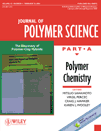Polymerization of 1,3-dienes with functional groups. III. Free-radical polymerization of N,N-diethyl-2-methylene-3-butenamide
Abstract
Free-radical homo- and copolymerization behavior of N,N-diethyl-2-methylene-3-butenamide (DEA) was investigated. When the monomer was heated in bulk at 60 °C for 25 h without initiator, rubbery, solid gel was formed by the thermal polymerization. No such reaction was observed when the polymerization was carried out in 2 mol/L of benzene solution with with 1 mol % of azobisisobutyronitrile (AIBN) as an initiator. The polymerization rate (Rp) equation was Rp ∝ [DEA]1.1[AIBN]0.51, and the overall activation energy of polymerization was calculated 84.1 kJ/mol. The microstructure of the resulting polymer was exclusively a 1,4-structure where both 1,4-E and 1,4-Z structures were included. From the product analysis of the telomerization with tert-butylmercaptan as a telogen, the modes of monomer addition were estimated to be both 1,4- and 4,1-addition. The copolymerizations of this monomer with styrene and/or chloroprene as comonomers were also carried out in benzene solution at 60 °C. In the copolymerization with styrene, the monomer reactivity ratios obtained were r1 = 5.83 and r2 = 0.05, and the Q and e values were Q = 8.4 and e = 0.33, respectively. © 2004 Wiley Periodicals, Inc. J Polym Sci Part A: Polym Chem 42: 999–1007, 2004




